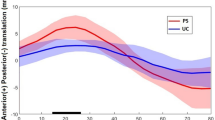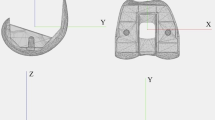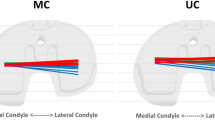Abstract
Purpose
Which total knee arthroplasty (TKA) design represents the better solution to restore a correct knee biomechanics is still debated. The aim of this study was to compare posterior stabilized (PS) and cruciate retaining (CR) version of the same TKA design (femoral component with an anatomic sagittal radius—J-curve design) by the use of dynamic Roentgen stereophotogrammetric analysis (RSA). The hypothesis was that the two models influence differently in vivo knee kinematic.
Methods
A cohort of 16 randomly selected patients was evaluated 9 months after surgery: Zimmer PERSONA® was implanted, eight with CR design and eight with PS design. The kinematic evaluations were performed using a Dynamic RSA (BI-STAND DRX 2) developed in our Institute, during the execution of the sit-to-stand motor task. The motion parameters were obtained using the Grood and Suntay decomposition and the low-point kinematics methods.
Results
PS TKA lateral femoral compartment had a wider anterior translation (17 ± 2 mm) than the medial one (11 ± 2 mm), while the two compartments of CR TKA showed a similar anterior translation (medial: 9 ± 2 mm/lateral: 11 ± 2 mm). T test for comparison between CR and PS TKA of antero-posterior translation showed a statistically significant difference (p < 0.05) in the flexion range between 15° and 40°. The CR prosthesis did not anteriorly translate during flexion. The PS design translated anteriorly showing a roll-forward mechanism during extension from 80° to 18° of flexion and a posterior translation from 18° to 0°. The same significant differences (p < 0.05) between the PS and CR groups were found comparing the low-point positions of the femoral condyles in the range of flexion between 25° and 40° for the medial compartment and between 15° and 25° for the lateral compartment.
Conclusions
Dynamic RSA was able to investigate for the first time in vivo the kinematic behaviour of PS and CR version of the same TKA J-curve design. PS type showed a medial pivot during sit-to-stand motion task, while the CR type showed a cylindrical movement. Further studies are needed to evaluate the impact of different TKA designs on clinical results.
Level of evidence
IV.







Similar content being viewed by others
Abbreviations
- ACL:
-
Anterior cruciate ligament
- AEC:
-
Automatic exposure control
- AP:
-
Anterior/posterior
- BMI:
-
Body mass index
- fps:
-
frames per second
- FU:
-
Follow-up
- HIPAA:
-
Health Insurance Portability and Accountability Act
- OA:
-
Osteoarthritis
- PCL:
-
Posterior cruciate ligament
- PS:
-
Posterior stabilized
- CR:
-
Cruciate retaining
- RSA:
-
Roentgen stereophotogrammetric analysis
- TKA:
-
Total knee arthroplasty
References
Evans JT, Walker RW, Evans JP, Blom AW, Sayers A, Whitehouse MR (2019) How long does a knee replacement last? A systematic review and meta-analysis of case series and national registry reports with more than 15 years of follow-up. Lancet 393:655–663
Clement ND, Bardgett M, Weir D, Holland J, Gerrand C, Deehan DJ (2018) Three groups of dissatisfied patients exist after total knee arthroplasty: early, persistent, and late. Bone Joint J 100-B:161–169
van den Boom LGH, Brouwer RW, van den Akker-Scheek I, Bulstra SK, van Raaij JJAM (2009) Retention of the posterior cruciate ligament versus the posterior stabilized design in total knee arthroplasty: a prospective randomized controlled clinical trial. BMC Musculoskelet Disord 10:119
Hamai S, Okazaki K, Shimoto T, Nakahara H, Higaki H, Iwamoto Y (2015) Continuous sagittal radiological evaluation of stair-climbing in cruciate-retaining and posterior-stabilized total knee arthroplasties using image-matching techniques. J Arthroplasty 30:864–869
Tang H, Chen H, Yang D, Jiang Y, Zhang C, Zhou Y (2017) Distinctions of introarticular force distribution between genesis-II posterior stabilized and cruciate retaining total knee arthroplasty: an intraoperative comparative study of 45 patients. Clin Biomech (Bristol, Avon) 42:1–8
Verra WC, van den Boom LGH, Jacobs W, Clement DJ, Wymenga AAB, Nelissen RGHH (2013) Retention versus sacrifice of the posterior cruciate ligament in total knee arthroplasty for treating osteoarthritis. Cochrane Database Syst Rev 10:CD004803
Bull AMJ, Kessler O, Alam M, Amis AA (2008) Changes in knee kinematics reflect the articular geometry after arthroplasty. Clin Orthop Relat Res 466:2491–2499
Bignozzi S, Zaffagnini S, Akkawi I, Marko T, Bruni D, Neri MP, Colle F, Marcacci M (2014) Three different cruciate-sacrificing TKA designs: minor intraoperative kinematic differences and negligible clinical differences. Knee Surg Sports Traumatol Arthrosc 22:3113–3120
Li G, Zayontz S, Most E, Otterberg E, Sabbag K, Rubash HE (2001) Cruciate-retaining and cruciate-substituting total knee arthroplasty: an in vitro comparison of the kinematics under muscle loads. J Arthroplasty 16:150–156
Li N, Tan Y, Deng Y, Chen L (2014) Posterior cruciate-retaining versus posterior stabilized total knee arthroplasty: a meta-analysis of randomized controlled trials. Knee Surg Sports Traumatol Arthrosc 22:556–564
Selvik G (1990) Roentgen stereophotogrammetric analysis. Acta Radiol 31:113–126
Bragonzoni L, Marcheggiani Muccioli GM, Bontempi M, Roberti di Sarsina T, Cardinale U, Alesi D, Iacono F, Neri MP, Zaffagnini S (2019) New design total knee arthroplasty shows medial pivoting movement under weight-bearing conditions. Knee Surg Sports Traumatol Arthrosc 27:1049–1056
Dai Y, Scuderi GR, Penninger C, Bischoff JE, Rosenberg A (2014) Increased shape and size offerings of femoral components improve fit during total knee arthroplasty. Knee Surg Sports Traumatol Arthrosc 22:2931–2940
Galea VP, Botros MA, Madanat R, Nielsen CS, Bragdon C (2019) Promising early outcomes of a novel anatomic knee system. Knee Surg Sports Traumatol Arthrosc 27:1067–1074
Kolisek FR, McGrath MS, Marker DR, Jessup N, Seyler TM, Mont MA, Lowry Barnes C (2009) Posterior-stabilized versus posterior cruciate ligament-retaining total knee arthroplasty. Iowa Orthop J 29:23–27
Fong JW-Y, Veljkovic A, Dunbar MJ, Wilson DA, Hennigar AW, Glazebrook MA (2011) Validation and precision of model-based radiostereometric analysis (MBRSA) for total ankle arthroplasty. Foot Ankle Int 32:1155–1163
Gascoyne TC, Morrison JB, Turgeon TR (2014) The effect of patient positioning on the precision of model-based radiostereometric analysis. J Biomech 47:1914–1917
Seehaus F, Emmerich J, Kaptein BL, Windhagen H, Hurschler C (2013) Dependence of model-based RSA accuracy on higher and lower implant surface model quality. Biomed Eng Online 12:32
Dabirrahmani D, Hogg M (2017) Modification of the Grood and Suntay Joint Coordinate System equations for knee joint flexion. Med Eng Phys 39:113–116
Grood ES, Suntay WJ (1983) A joint coordinate system for the clinical description of three-dimensional motions: application to the knee. J Biomech Eng 105:136–144
JCGM (2008) JCGM100: guide to the expression of uncertainty in measurements. https://www.iso.org/sites/JCGM/GUM-JCGM100.htm
Rajgopal A, Aggarwal K, Khurana A, Rao A, Vasdev A, Pandit H (2017) Gait parameters and functional outcomes after total knee arthroplasty using persona knee system with cruciate retaining and ultracongruent knee inserts. J Arthroplasty 32:87–91
Bergfeld JA, McAllister DR, Parker RD, Valdevit AD, Kambic H (2001) The effects of tibial rotation on posterior translation in knees in which the posterior cruciate ligament has been cut. J Bone Joint Surg Am 83:1339–1343
Komistek RD, Dennis DA, Mahfouz M (2003) In vivo fluoroscopic analysis of the normal human knee. Clin Orthop Relat Res 410:69–81
Banks SA, Hodge WA (2004) Implant design affects knee arthroplasty kinematics during stair-stepping. Clin Orthop Relat Res 426:187–193
Carvalho LH, Temponi EF, Soares LFM, Gonçalves MJB (2014) Relationship between range of motion and femoral rollback in total knee arthroplasty. Acta Orthop Traumatol Turc 48:1–5
Banks SA, Markovich GD, Hodge WA (1997) In vivo kinematics of cruciate-retaining and -substituting knee arthroplasties. J Arthroplasty 12:297–304
Yoshiya S, Matsui N, Komistek RD, Dennis DA, Mahfouz M, Kurosaka M (2005) In vivo kinematic comparison of posterior cruciate-retaining and posterior stabilized total knee arthroplasties under passive and weight-bearing conditions. J Arthroplasty 20:777–783
Chaudhary R, Beaupré LA, Johnston DWC (2008) Knee range of motion during the first two years after use of posterior cruciate-stabilizing or posterior cruciate-retaining total knee prostheses. A randomized clinical trial. J Bone Joint Surg Am 90:2579–2586
Abdel MP, Morrey ME, Jensen MR, Morrey BF (2011) Increased long-term survival of posterior cruciate-retaining versus posterior cruciate-stabilizing total knee replacements. J Bone Joint Surg Am 93:2072–2078
Maruyama S, Yoshiya S, Matsui N, Kuroda R, Kurosaka M (2004) Functional comparison of posterior cruciate-retaining versus posterior stabilized total knee arthroplasty. J Arthroplasty 19:349–353
Mayne A, Harshavardhan H, Johnston L, Wang W, Jariwala A (2017) Cruciate Retaining compared with Posterior Stabilised Nexgen total knee arthroplasty: results at 10 years in a matched cohort. Ann R Coll Surg Engl 99:602–606
Kim Y-H, Choi Y, Kwon O-R, Kim J-S (2009) Functional outcome and range of motion of high-flexion posterior cruciate-retaining and high-flexion posterior cruciate-substituting total knee prostheses. A prospective, randomized study. J Bone Joint Surg Am 91:753–760
Baier C, Springorum H-R, Götz J, Schaumburger J, Lüring C, Grifka J, Beckmann J (2013) Comparing navigation-based in vivo knee kinematics pre- and postoperatively between a cruciate-retaining and a cruciate-substituting implant. Int Orthop 37:407–414
Ginsel BL, Banks S, Verdonschot N, Hodge WA (2009) Improving maximum flexion with a posterior cruciate retaining total knee arthroplasty: a fluoroscopic study. Acta Orthop Belg 75:801–807
Murakami K, Hamai S, Okazaki K, Ikebe S, Nakahara H, Higaki H, Shimoto T, Mizu-Uchi H, Kuwashima U, Iwamoto Y (2017) Kinematic analysis of stair climbing in rotating platform cruciate-retaining and posterior-stabilized mobile-bearing total knee arthroplasties. Arch Orthop Trauma Surg 137:701–711
Joglekar S, Gioe TJ, Yoon P, Schwartz MH (2012) Gait analysis comparison of cruciate retaining and substituting TKA following PCL sacrifice. Knee 19:279–285
Funding
This study was partially funded by Zimmer Inc., Warshaw, Indiana, USA.
Author information
Authors and Affiliations
Corresponding author
Ethics declarations
Conflict of interest
The authors declare that they have no conflict of interest.
Ethical approval
This study obtained the approval of the Ethics Committee of the IRCCS Rizzoli Orthopaedic Institute (IRB statement: 0012645 approved 2014/04/03).
Additional information
Publisher's Note
Springer Nature remains neutral with regard to jurisdictional claims in published maps and institutional affiliations.
Rights and permissions
About this article
Cite this article
Bontempi, M., Roberti di Sarsina, T., Marcheggiani Muccioli, G.M. et al. J-curve design total knee arthroplasty: the posterior stabilized shows wider medial pivot compared to the cruciate retaining during chair raising. Knee Surg Sports Traumatol Arthrosc 28, 2883–2892 (2020). https://doi.org/10.1007/s00167-019-05645-6
Received:
Accepted:
Published:
Issue Date:
DOI: https://doi.org/10.1007/s00167-019-05645-6




